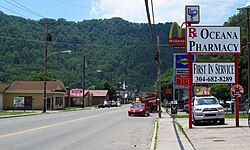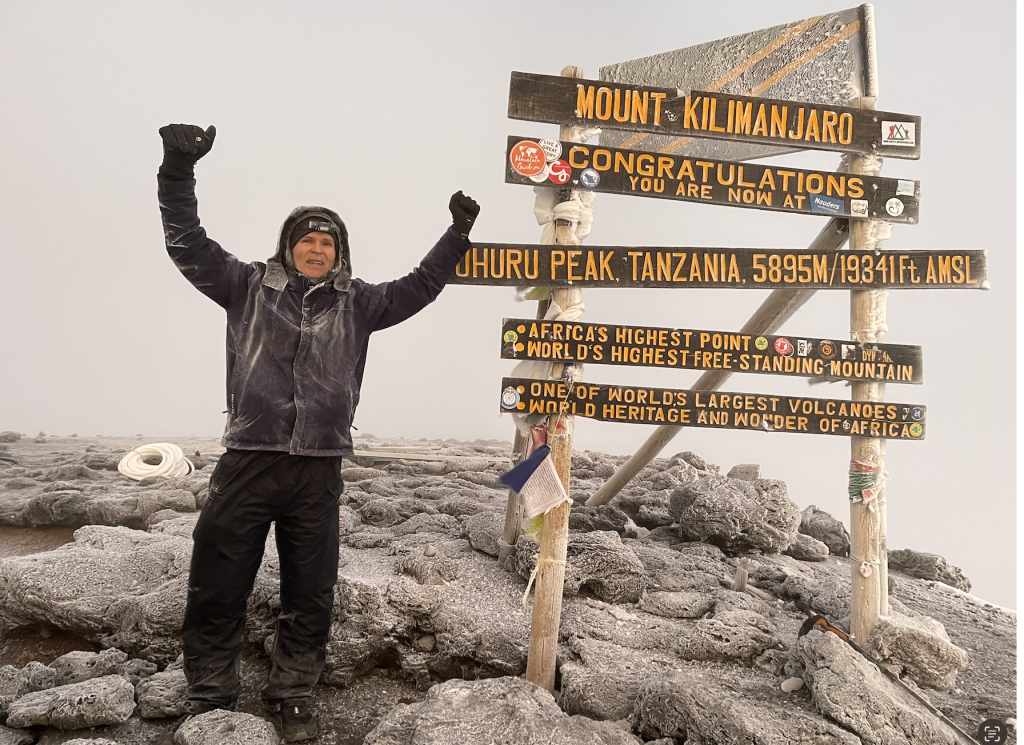Chapter 6: The Geography of Language
6.7 Language in the Business and Digital Worlds
6.7.1 Language and the Discourse of Advertising
Commercial advertisement occupies a noticeable expanse in the cultural landscape. An individual text (use and arrangement of specific language forms) is designed to promote or sell a product within a social context. A commercial text may be accompanied by music and visual depictions. The text may also be accompanied by paralanguage features of oral language (gestures, voice quality, facial expressions) and written language (choice of typeface, letter sizes, range of colors).
The advertisement itself brings up several discourse concerns: Who (seller) is communicating

Source: "Oceana, West Virginia.jpg" by Magnolia677 via Wikimedia Commons is licensed under CC BY-SA 3.0.
with Whom (consumer) and Why (inform/convince/persuade about the product’s importance/usefulness/ uniqueness)? The participants in the discourse may include various message senders/participants: the actor/s in the TV commercial along with the supporting role of the advertising agency and the studio production staff. The receivers may be a specific target group or anyone who sees the advertisement.
Highway billboards, store signs and product advertisements provide a visual representation of commercial language use in a community. Most billboard structures are located on public spaces and display advertisements to passing motorists and pedestrians. They can also be placed in other locations where there are many viewers (mass transit stations, shopping malls, office buildings and sports’ stadiums).

Source: "1 times square night 2013.jpg" by chensiyuan via Wikimedia Commons is licensed under CC BY-SA 4.0.
.Some billboards may be static, while others may change continuously or rotate periodically with different advertisements. In addition, there are product promotions within a retail store, which often involve product placements at the end of aisles and near checkout counters.
Novelty ads can appear on small tangible items such as coffee mugs, t-shirts, pens and shopping bags. They can be distributed directly by the advertiser or as part of cross-product promotion campaigns. Advertisers use the popularity of cultural celebrities in the worlds of sports, music and entertainment to promote their products. Even aircrafts, balloons and skywriting are used as moveable means to display advertisements.
Store signs and highway billboards can be viewed as a visual language trail, stretching from point A to point B on Highway X in a specific geographic area. Depending on the population characteristics of a location, diverse forms of advertisement are used to convince the customer that a company’s services or products are the best in quality and price, most useful, and socially desired. A drive through various roads and highways across the Eastern Shore of Virginia, especially along the causeway towards Chincoteague, reveals a multitude of billboards addressing the incoming tourists. In Forbes Magazine journalist Gary Stoller writes about Chincoteague’s Strange Dichotomy: From Billboard Blight To Nature's Wonders.
The visual content and design of an advertisement aimed to draw attention to a specific product might focus on customer needs such items as food, clothing, furniture, restaurants, home and garden, cosmetics and beauty care, auto maintenance, fitness and recreation, travel and hotels, communication, and computers. The advertising style for product promotion often tends to be laudatory, positive, and emphasizing uniqueness. The vocabulary is usually vivid and concrete, involving play-on-words and commercial slogans in some cases. Ads rely primarily on language, and it is the visual content and design that create an interest in the product and persuade people to buy it.
The advertisement of services for the general population and targeted ethnolinguistic communities might encompass health services (doctors, dentists, hospital and emergency care), financial institutions (banks, credit unions, home, and car loans, bail bonds), legal services (lawyers, notary public, public defenders) and community resources (schools, libraries, museums, parks). Customer needs usually dictate what services are available in a specific geographic area. Interest in niche marketing or ads targeted to a specific social group represents the strong relationship that exists between cultural and technological changes in contemporary US society.

The signs atop Mount Kilimanjaro, as seen in Figure 6.7.3, function not only as advertisements but also as acknowledgments of the accomplishment of climbing Africa's highest peak. Additionally, they offer pertinent information regarding the mountain's elevation, its status as a World Heritage Site, and its being Africa's wonder. It also mentions that this is a volcano and, thus, a free-standing mountain.
6.7.2 Language and the Digital World
Social media are computer-mediated technologies that allow multiple senders and receivers to create and share information, ideas, career interests, and other forms of expression via virtual communities and communication networks. Social media use relies on web-based technologies such as desktop computers, smartphones, and tablet computers to create highly interactive formats that allow individuals, communities, and organizations the possibility to share, co-create, discuss diverse topics, and comment on content previously posted online. Social media allows for mass cultural exchanges and intercultural communication among people from different regions of the world.
The term social media is often used to indicate that many senders and receivers can communicate almost simultaneously across space and time. At the same time, the term social media is used to mean social networks (relationships and contacts among many individuals). If one is using the term to mean social networks (who interacts with whom in the linguistic community), then the researcher can “observe” and document the interactional patterns or the researcher can “interview” the participants to determine the type of social networks. Social networks, from a sociolinguistic perspective, can be differentiated on the basis of whether they are “dense” or “loose”. In dense networks, all members know each other. In loose networks, not all members know each other. Networks can also be distinguished by the quality of ties (connections) that exist among the members. In uniplex ties, individuals are connected by one type of relationship (participate in the same swim club, take the same courses at a college, work in the same business). In multiplex ties, members know each other in several different roles (student/friend/classmate; parent/co-worker/neighbor).
The term social media is usually associated with different networking sites such as the following:
- Facebook, an online social network which allows users to create personal profiles, share photos and videos and communicate with other users.
- Twitter, now X, an internet service that allows users to post “tweets” (brief messages totaling 140 characters) for their followers to see in real-time.
- LinkedIn, a network designed for the business community allowing users to create professional profiles, post resumes, and communicate with other professionals and job-seekers.
- Pinterest, an online network that allows users to send photos of items found in the web by“pinning” them and sharing comments with others in the virtual community.
- Snapchat, an application on mobile devices that allows users to send and share photos of themselves performing daily activities.
- TikTok, an application where users can customize their videos with filters, stickers and background music, then share them with the TikTok community.
- Instagram, an application where people can upload photos or videos and share them with their followers or with a select group of friends.
Social media takes many other forms including blogs, forums, product/services reviews and social gaming and video sharing. The social networking world has changed the way individuals and organizations use language to communicate with each other. Research findings indicate the significant impact that social media is having on society in the United States and elsewhere.
| # | Network | Number of Users (millions) | Country of Origin |
|---|---|---|---|
| 1 | 3,049 | United States | |
| 2 | YouTube | 2,491 | United States |
| 3 | 2,000 | United States | |
| 3 | 2,000 | United States | |
| 5 | TikTok | 1,526 | China |
| 6 | 1,336 | China | |
| 7 | Facebook Messenger | 979 | United States |
| 8 | Telegram | 800 | Russia |
| 9 | Douyin | 752 | China |
| 10 | Snapchat | 750 | United States |
| 11 | Kuaishou | 685 | China |
| 12 | 619 | United States |
Figure 6.7.4 Social media usage in the US. 2023
Source: "Social networking services with the most users, January 2024" From Wikipedia.

Source: "Most used social networks 2024, by number of users" Published by Stacy Jo Dixon, Jul 10, 2024 via Statista.
There are both positive and negative effects associated with social media. The positive effects include the ability to document memories, learn about and explore different topics, advertise oneself and form many friendships. On the negative side, social media often invades on personal privacy, fosters information overload, promotes isolation, affects users’ self-esteem and creates the possibility for online harassment and cyberbullying.
Mapping actual language use in the context of the digital world is problematic. It is a complex communication universe. Unlike the geography of place names and the discourse of advertisement, social networking occurs in a virtual environment, involving many senders/receivers and different computer-mediated technologies. Data “mining” is a technique employed to analyze large-scale social media data fields to establish general patterns regarding the content/topics that emerge from people’s actual online activities. Usage patterns in social media interest many advertisers, major businesses, government organizations and political parties. Research methods from the social sciences have been used to establish user’s activities with different types of social media technologies. These include pencil-and-paper questionnaires, individual/group oral interviews and focus group sessions. These methods involve language-driven interactions with a limited number of users who may or may not reveal their actual social media patterns of behavior.

